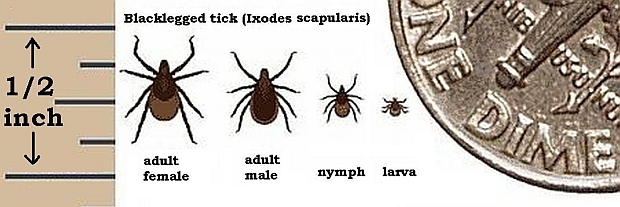
21 April 2015
Yes, it’s time to get outdoors but remember there are dangers out there.
Not bears and mountain lions. I’m talking about deer ticks, also known as black-legged ticks (Ixodes scapularis). They transmit Lyme disease and it can ruin your life for a very long time.
Tick season never ends but it’s really dangerous in the spring and early summer. Most Lyme disease is transmitted in May through July when the deer ticks’ tiny poppy-seed-sized nymphs are active and we’re active too. We don’t notice the nymph, or we forget — or don’t know — the basics of protection against Lyme disease.
Here are the basics with great help from the TickEncounter website at the University of Rhode Island.
- Know the enemy. Click here for details.

- Avoid the enemy. Click here for more.
- Wear light-colored long pants, long sleeves and a collar.
- Tuck your shirt in.
- Walk in the center of the trail. Before you walk off trail, tuck your pants into your socks and keep them that way. Did you know ticks lurk in leaf litter, too?
- Pre-treat your clothing and shoes with permethrin. Read and follow label directions. TickEncounter says this substitutes for (a) and (c) and works better than DEET!
- Protect your yard and your pets with tips found here.
- Do a daily tick check. Yes, daily! You might have missed one yesterday. Here’s how to check.
- When you take off your hiking clothes, immediately dry them for 10 minutes in a hot dryer. Really. This kills ticks.
- If you find a tick remove it correctly (here’s how) and save it for testing. Send it here and they’ll tell you if it carries Lyme disease.
I thought I knew about deer ticks but I learned valuable new information at the TickEncounter Resource Center. Visit their website here.
Forewarned is forearmed.
p.s. Even if your clothes are sprayed with permethrin, don’t bushwhack through Bush honeysuckle or Japanese barberry. Those two shrubs are tick magnets!
(photo of clothes and dryer by Kate St. John. tick chart from the Center for Disease Control via Wikimedia Commons. Click on the chart to see the original)
I REALLY appreciate this information! Thanks!
Thanks for the reminder! We were out all day on Sunday (wildflowers galore at the Eckert Bridge near McConnell’s Mill)….
Kate, I’d like to thank you for the pointer to the TickEncounter Resource Center. What a great resource! I’d rather spray my hiking clothes with permethrin than spray myself with DEET. And the other information they have, like putting out mouse nesting material that contains permethrin to kill the ticks that come in contact with the mice is great also.
Can never have enough info on tick protection. There is a certain gorgeous but risky wooded area I have frequented for several years, and I often emerge with over one dozen ticks creeping up my pant legs and shirt sleeves.
I usually find myself detaching at least a few each summer. My best advice is strip down after forest and field visits and search EVERYWHERE (can’t overemphasize everywhere in this instance…they can get around!).
I even found 3 or 4 teeny-tiny babies in early March this spring while looking for skunk cabbage!
I was telling a friend of mine about the TickEncounter Resource Center advice, and she was horrified. She said that permethrin is fairly toxic to the environment. I looked it up online and it says that it does indiscriminately kill all insects, beneficial and harmful, and is very toxic to fish if it washes into streams, and to cats, although most other mammals don’t absorb it well through their skin so it’s not too toxic to humans. So perhaps it’s not a good alternative to DEET.
Mary Ann, yes Permethrin is toxic. (It should never be applied to skin — which tells you something!) Using Permethrin vs. DEET vs. ‘natural’ repellents is a case of making an effective choice to prevent a life altering illness. (Use only enough to stop the ticks, not kill the fish.).
Those who are rarely in tick-infested places, don’t need any repellent at all — just be vigilant to check and recheck for ticks after returning home.
Those who live where it’s impossible to go outdoors without picking up deer ticks and where Lyme disease is prevalent, will want a very effective solution. So there are many shades of gray. See TickEncounter’s comment on this topic: Tick bite prevention Question #5
Ticks are nothing to mess with! I know several people who’ve had Lyme disease. It’s awful if not treated very early!
p.s. I know of several tick-infested places — in PA, NJ and New England. I avoid ticks at those sites by never going to those places again.